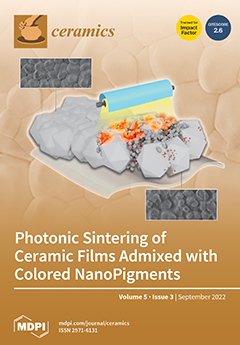Synthetic 11 Å tobermorite (Ca
5Si
6O
16(OH)
2.4H
2O) and its Al-substituted analogue are layer-lattice ion-exchangers with potential applications in nuclear and hazardous wastewater treatment. The present study reports the facile one-pot hydrothermal synthesis of an Al-tobermorite-rich cation-exchanger from a combination of paper recycling ash, post-consumer container glass, and lime, with compositional ratios of [Ca]/[Si + Al] = 0.81 and [Al]/[Si + Al] = 0.18. The reaction products were characterized by powder X-ray diffraction analysis,
29Si magic angle spinning nuclear magnetic resonance spectroscopy, and scanning electron microscopy. Hydrothermal processing in 4 M NaOH
(aq) at 100 °C for 7 days yielded an Al-tobermorite-rich product that also contained katoite (Ca
3Al
2SiO
12H
8), portlandite (Ca(OH)
2), calcite (CaCO
3), and amorphous silicate gel. The hydrothermal product was found to have a Cs
+ cation exchange capacity of 59 ± 4 meq 100 g
−1 and selective Cs
+ distribution coefficients (
Kd) of 574 ± 13 and 658 ± 34 cm
3 g
−1 from solutions with molar ratios [Cs
+]:[Na
+] and [Cs
+]:[Ca
2+] of 1:100. In a batch sorption study at 20 °C, the uptakes of Pb
2+, Cd
2+, and Cs
+ were determined to be 1.78 ± 0.04, 0.65 ± 0.06, and 0.36 ± 0.03 mmol g
−1, respectively. The kinetics of Pb
2+, Cd
2+, and Cs
+ removal were described by the pseudo-second-order rate model, which gave respective rate constants (
k2) of 0.010, 0.027, and 1.635 g mmol
−1 min
−1, and corresponding correlation coefficients (
R2) of 0.997, 0.996, and 0.999. The metal ion sorption properties of the tobermorite-rich product compared favorably with those of other waste-derived tobermorites reported in the literature. Potential strategies to improve the yield, crystallinity, and sorption characteristics of the product are discussed.
Full article





